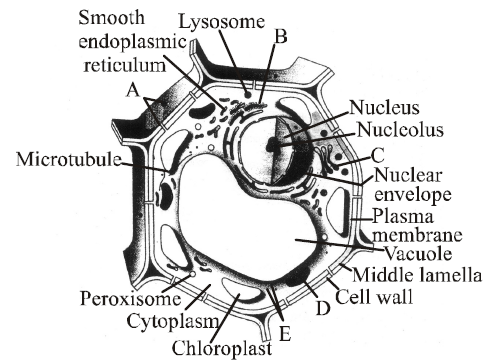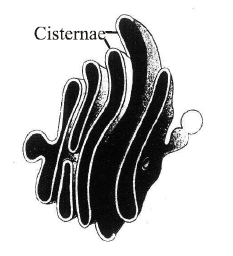Both the membranes of mitochondrion are
structurally different but functionally similar.
structurally as well as functionally different.
structurally similar but functionally different.
structurally different but functionally similar.
Correct Answer :
B. structurally as well as functionally different.
The mitochondrion is a double membrane-bound organelle found in most eukaryotic cells. It contains outer and inner membranes composed of phospholipid bilayers and proteins. The two membranes have different properties. Because of this double-membrane organization, there are five distinct parts to a mitochondrion- the outer mitochondrial membrane, the intermembrane space (the space between the outer and inner membranes), the inner mitochondrial membrane, the cristae space (formed by infolding's of the inner membrane), and the matrix (space within the inner membrane). Mitochondria are also called as the power house of the cell.
Related Questions
Read the statements given below with regard to the functions performed by Golgi apparatus ?
- Transport and chemically modify the materials contained within it.
- Performs the function of packaging materials.
- Important site of formation of glycoproteins and glycolipids.
Which of the following is the correct answer ?
(i) is wrong but (ii) and (iii) are correct
(ii) is wrong but (i) and (iii) are correct
(ii) and (iii) are wrong but (i) is correct
All are correct.
The following diagram shows some of the missing structures in a plant cell marked as A, B, C, D E. Choose the option with their correct names.

A - Plasmodesmata, B - Rough endoplasmic reticulum, C - Golgi apparatus, D - Mitochondrion, E - Ribosomes
A - Desmosome, B - Rough endoplasmic reticulum, C - Golgi apparatus, D - Mitochondrion, E - Ribosomes
A - Plasmodesmata, B - Smooth endoplasmic reticulum, C - Golgi apparatus, D - Mitochondrion, E - Ribosomes
A - Tight junction, B - Rough endoplasmic reticulum, C - Golgi apparatus, D - Mitochondrion, E -Ribosomes
Difference between the prokaryotic and eukaryotic cells in having
cell wall
nuclear membrane
ribosome
none of these
Which of the following statements are correct ?
- In prokaryotic cells, a special membranous structure formed by the extension of the plasma membrane into the cell is known as polysome.
- The smooth endoplasmic reticulum is the major site for synthesis of glycoproteins.
- RuBisCO is the most abundant protein in the whole biosphere.
- Mitochondria, chloroplasts and peroxisomes are not considered as part of endomembrane system. Of the above statements
(iii) and (iv)
(i) and (ii)
(ii) and (iii)
(i) and (iv)
Which of the following statement is false?
The ribosomes of a polysome translate the mRNA into protein.
Mitochondria divide by fragmentation.
All cell arise from pre-existing cells.
The lipid component of the membrane mainly consists of phosphoglycerides.
Axoneme with 9 + 2 microtubular arrangement occurs in
cilia
flagella
both (a) and (b)
centriole
Satellite means
terminal part of the chromosome beyond secondary constriction.
terminal part of the chromosome beyond primary constriction.
terminal part of chromosome beyond tertiary constriction.
none of the above
Match column-I with column-II and select the correct option.
| Column - I | Column - II |
|---|---|
| A. Golgi apparatus | I. Storage |
| B. Mitochondria | II. Photosynthesis |
| C. Vacuoles | III. Transport |
| D. Grana | IV. Secretion |
| .. | V. Respiration |
A - IV, B - V, C - I, D - II
A - I, B - II, C - IV, D - III
A - IV, B - I, C - II, D - III
A - I, B - II, C - III, D - IV
8.A student was given cell samples (A and B) to identify parts which are highlighted. He observed the samples under the microscope and list down the function of the part of cell sample. The information collected by the student is listed in the table below, on the basis of which the student infers that the samples contain the organelles.
| Sample A | Sample B |
|---|---|
| Make energy available for cellular metabolism | Generates ATP and synthes izes s ugar |
| Absent in cell that carry oxygen throughout the body | Present in plant cell |
| Called the energy currency of cell | Source o f all the food energy |
Identify the part highlighted in the sample A and B and explain why they were called as semi-autonomous organelles?
Sample A - Mitochondria, Sample B - Chloroplast; because both the organelles are double membrane bound structure.
Sample A- Mitochondria, Sample B - Chloroplast; because they both are capable of synthesis of their own proteins only.
Sample A - Mitochondria, Sample B - Chloroplast; because they are capable of synthesis of their own proteins and contain their own DNA.
Sample A- Mitochondria, Sample B - Chloroplast; because they contain their own DNA to transfer the genetic information from one generation to another.
The main organelle involved in modification and routing of newly synthesized proteins to their destinations is
chloroplast
mitochondria
lysosome
endoplasmic reticulum
_______________ is the important site of formation of glycoproteins and golycolipids.
SER
Lysosome
Golgi apparatus
Mitochondria
The best way to identify a cell as either prokaryotic or eukaryotic is to determine whether
it came from a single-celled or multicellular organism.
it has a nucleus.
it has a plasma membrane.
it has cytosol.
The figure below shows the structure of a mitochondrion with its four parts labelled (A), (B), (C) and (D).

Select the part correctly matched with its function.
Part (D): Outer membrane Gives rise to inner membrane by splitting.
Part (B): Inner membrane Forms infoldings called cristae.
Part (C): Cristae Possess single circular DNA molecule and ribosomes.
Part (A): Matrix Major site for respiratory chain enzymes.
Study the following statements on cilium or flagellum and answer the question.
- Cilium / Flagellum contains an outer ring of nine doublet microtubules surrounding two singlet microtubules.
- Cilia are smaller which work like oars, causing the movement of either the cells or surrounding fluid.
- Flagella are comparatively longer and responsible for cell movement.
- Cilium and flagellum are covered with plasma membrane.
Which of the above statements are correct?
(i) and (ii)
(i), (ii), (iii) and (iv)
(i) and (iv)
(ii) and (iii)
Which one of the following pairs is not correctly matched?
Cristae The tubular structure formed by the folding of the inner membrane of the mitochondrion.
Plasmodesmata The membrane surrounding the vacuole in plants.
Grana Membrane bound discs in chloroplasts that contain chlorophylls and carotenoids.
Middle lamella Layer between adjacent cells walls in plants derived from cell plate.
The lipid component of the membrane mainly consists of __________.
polysaccharides
phosphoglyceride
monosaccharaides
both (a) and (c)
Choose the wrong statements regarding bacterial cell
- Glycocalyx is the outermost envelope in bacteria.
- The glycocalyx could be a loose sheath called capsule.
- The glycocalyx may be thick and tough called slime layer.
- A special structure formed by the plasma membrane is called mesosome.
- Small bristle like fibres sprouting out of the cell are called fimbriae.
(i) and (iii)
(i) and (ii)
(ii) and (iii)
(i) and (iv)
Match column-I (scientists) with column-II (discovery) and select the correct option.
| Column-I | Column-II |
|---|---|
| A. Leeuwenhoek | I. First saw and described a living cell |
| B. Robert Brown | II. Presence of cell wall is unique to plant cells |
| C. Schleiden | III. Discovered the nucleus |
| D. Schwann | IV. All plants are composed of different kind of cells |
A I, B III, C IV, D II
A I, B III, C II, D IV
A III, B I, C IV, D II
A I, B IV, C II, D III
Basal bodies are associated with the formation of
phragmoplast
cilia and flagella
cell plate
kinetochore
Grana are
protein storing plastids.
coloured plastids.
stacks of thylakoids.
individual thylakoids present in stroma.
Active transport across biomembrane involves
production of ATP
requirement of energy
production of toxin
release of energy
Which of the following cell organelles were discovered after the introduction of electron microscope?
Mitochondria
Endoplasmic reticulum
Ribosomes
Both (b) and (c)
In prokaryotes, chromatophores are
specialized granules responsible for colouration of cells
structures responsible for organizing the shape of the organism.
inclusion bodies lying free inside the cells for carrying out various metabolic activities.
internal membrane system which becomes extensive and complex in photosynthetic bacteria.
Which one of the following is not considered as part of the endomembrane system?
Golgi complex
Peroxisome
Vacuole
Lysosome
Lysosomes contain
carbohydrates
hormones
nucleic acids
hydrolases.
Identify the cell organelle given below. Which is an important site of formation of glyeoproteins & glycolipids

Rough endoplasmic reticulum
Smooth endoplasmic reticulum
Golgi body
mitochondria
Most of water, in mature plant cells occurs in
nucleus
cell wall
vacuoles
cytoplasm
Polysome is a chain of
oxysomes
sphaerosomes
ribosomes
dictyosomes
Match column-I with column-II and choose the correct option.
| Column-I | Column-II |
|---|---|
| A. Tonoplast | I. Contain digestive enzyme |
| B. Contractile vacuole | II. Store metabolic gases |
| C. Food vacuole | III. Excretion |
| D. Air vacuole | IV. Transport of ions in plants |
A IV; B III; C I; D II
A II; B III; C IV; D I
A IV; B II; C III; D I
A I; B III; C II; D IV
Centrioles and centrosomes occur in the cells of
green plants
animals
bacteria and cyanobacteria
both (b) and (c)
